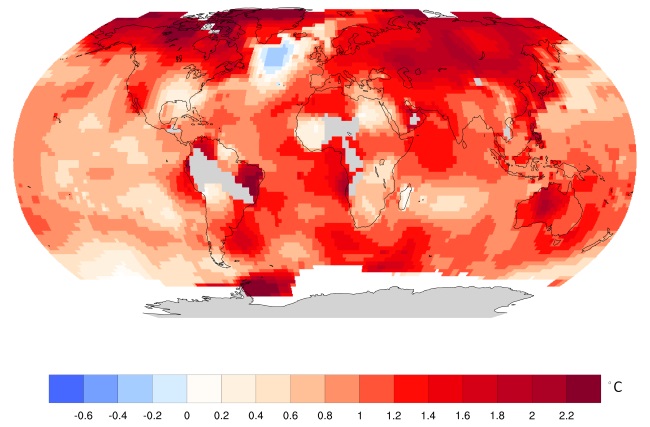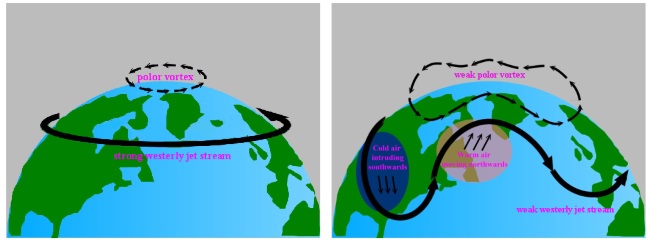"Polar Vortex" in a Warming World
27 February 2019
The year 2019 started with extreme temperatures in the two Hemispheres. In the Southern Hemisphere, Australia experienced an extraordinary heatwave and the hottest January on record with temperatures exceeding 49oC in parts of South Australia. In the Northern Hemisphere, the "polar vortex" brought bitterly cold temperatures to the Midwest of the United States in January. According to media reports, temperatures in Chicago fell to -30oC, even colder than parts of Antarctica. One could anticipate that climate change deniers will take this opportunity to cast doubt on the human-caused global warming whenever there are extreme cold weather events somewhere in the world (CMS: Is Global Warming Really at Work?). The usual deniers' tactic is to conflate short-term weather fluctuations and long-term climate trends. However, short-term fluctuations in weather say nothing about long-term trends in climate (CMS: The ABC's of Climate). As rightly pointed out by climate experts in the United States, we need to look at the big picture instead of confining our view to a short time horizon and a small area on the Earth's surface. Globally speaking, there is a lopsided ratio of hot records to cold records at land-based stations in the last 12 months, roughly about 8.3 to 1 [1]. In a longer term, almost every corner on Earth experienced a warming trend in the past 117 years (Figure 1).
What about the polar vortex? Is it undergoing any changes? As illustrated in Figure 2 for the case of the Northern Hemisphere, the polar vortex is the tight band of swirling winds in the upper atmosphere that confines cold air to the Arctic. If the polar vortex is weak, the westerly jet stream will be weakened and become wavier, favouring southward incursions of Arctic air mass, which will bring bitterly cold weather to the mid-latitudes (CMS: Polar Vortex). A recent study reveals that weak states of the polar vortex have become more persistent in the past four decades [2] against the backdrop of global warming. Scientists put the blame on the diminishing Arctic sea ice because the uncovered ocean releases more heat to the atmosphere aloft, thereby changing the atmospheric circulation. The diminishing Arctic sea ice also contributes to the amplified warming of the Arctic through the "climate-albedo" feedback mechanism: less sea ice -> darker ocean surface exposed -> more solar heat absorbed -> further sea ice loss. The Arctic is now warming at a rate twice the global average. Such differential warming causes the temperature contrast between the polar region and the equator to decrease, which in turn weakens the polar vortex and the westerly jet stream, making the westerly jet stream wavier and favouring outbreaks of frigid air from the north pole to the south (Blog: Warm Arctic, Cold Continents). A recent study also reveals that a warm Arctic means colder and snowier winters in Northeastern United States [3].
While more research is needed to further prove or disprove the aforementioned theory, there is no time for us to play a waiting game in the midst of climate change. The atmospheric concentration of carbon dioxide in 2017 reached a record high of 405.5 ppm and keeps on rising. Global carbon dioxide emissions in 2018 are set to hit an all-time high. If we want to achieve the goals of the Paris Agreement, significant reduction of carbon emissions is required. As pointed out by the UN Emissions Gap Report 2018, the mitigation ambitions agreed at the Paris climate summit need to be roughly tripled if we want to contain global temperature rise to within 2oC. The mitigation ambitions would need to increase fivefold if we want to limit global warming to within 1.5oC. It's high time to step up our efforts to combat climate change.
S M Lee, F C Sham
References:
[1] Bitterly cold extremes on a warming planet: Putting the Midwest's late January record cold in perspective
https://www.climate.gov/news-features/blogs/beyond-data/bitterly-cold-extremes-warming-planet-putting-midwest%E2%80%99s-late-january
[2] Winter cold extremes linked to high-altitude polar vortex weakening
https://www.pik-potsdam.de/news/press-releases/winter-cold-extremes-linked-to-high-altitude-polar-vortex-weakening
[3] Warm Arctic means colder, snowier winters in Northeastern U.S.
https://news.rutgers.edu/news/warm-arctic-means-colder-snowier-winters-northeastern-us-study-says/20180309

Figure 1 Warming trend during 1901-2017
(Data source: National Aeronautics and Space Administration, U.S.)

Figure 2 A stable (left) and a weak (right) polar vortex